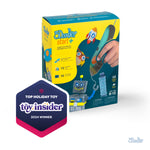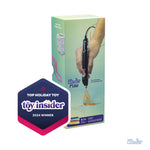How to Draw with a 3D Pen?
Drawing in 3D may seem daunting at first, but that’s only because it’s new. There is a learning curve, but with a bit of practice and with the tips and tricks in this guide, we promise you’ll find using a 3D pen to be second nature in no time!

Start with 2D
Drawing in 3D for a beginner starts with… wait for it… 2D. To help you get used to the speed of the pen and the way the different plastics behave, we suggest kicking off with drawing in 2D. Choose a clean, flat surface like a piece of paper.
Now grab a pencil and draw something simple on the paper (some lines and basic shapes would work great), or print out this stencil.

Step 1
Place the tip of your 3D pen at the starting point of your stencil and make sure it is touching the paper. Engage the feed mechanism, and extrude a small bead of plastic. This little bead is what we call an “anchor point”, because it will hold your Doodle to the paper.

Step 2
As you continue to trace along the stencil, try to keep the extruded plastic as close as you can to the paper. To stop Doodling, press the feed button button once, gently push down to form the ending point, wait 2-3 seconds, then pull your pen away.

Step 3
In order to join two pieces together, simply extrude some plastic for at the place where you want to merge the pieces to “weld” them into one piece.

Step 4
Once you’re done Doodling, allow the plastic to fully cool and harden for a few seconds, then gently peel it off the surface.

Draw Freehand in 3D
Once you’re confident drawing in 2D, it’s time to level up! Drawing freehand in the air gives you a whole new world of creative possibilities (and also makes people go “wow”).
Once you feel comfortable with this technique, challenge yourself to this simple 3D Dog Doodle!

Step 1
Start with Doodling a dot on a piece of paper, making sure it’s well anchored to the surface.

Step 2
Slowly lift the pen into the air while extruding, moving your pen at the same speed as the extrusion. The control of speed that you move your hand with is the trickiest part of drawing with a 3D pen, and will make or break your design. Take your time to practice and master this technique.

Step 3
When you have stopped the extrusion, hold the pen still for a few seconds to allow the plastic to solidify, then gently pull the pen away.

Step 4
Use the same technique to draw curves or spirals by moving your pen in the appropriate direction. Doodle in Slow mode until you get a good hang of this technique. ABS plastic is easier to control for drawing in the air.

Assemble and Build a 3D Object
Looking to make truly killer 3D objects? Doodling freehand in the air works great and is definitely a lot of fun, but there are also other handy techniques that you can try out as you take on different projects.
In this section, we look at how you can assemble a 3-dimensional object using Doodled 2D parts (a little like building with Lego blocks), as well as how you can make your own molds.
Build a Cube
A great way to practice assembling your Doodles, particularly larger or more intricate ones, is by building a cube. You can use the same technique to go beyond 3D cubes to create almost any structure.

Step 1
On a piece of paper, draw a 3x3cm square. Doodle to create six two-dimensional square pieces.

Step 2
Place the bottom piece flat on your work surface, then hold up a side piece so that it’s propped up against the bottom piece.

Step 3
Apply a bit of plastic at the corners where the pieces meet to hold it in place. Then Doodle along the entire joint to secure it.

Step 4
Repeat for each side of the cube, and you’re done!
Build a Sphere
When creating a round shape like a sphere, we recommend using a mold to get that perfect 3D shape. Your molds can be made out of rolled up paper and masking tape, or you can use and recycle items you already have at home!

Step 1
Get started by using a ping pong ball (or another small ball) as your 3D mold. Doodle a line around the middle of the ball, and work your way toward one end to create a semi-sphere.

Step 2
Leaving a little space, Doodle another semi-sphere on the other side of the ball.

Step 3
Use the file from a pair of nail clippers or scissors to slide around the inside of each semi-sphere to pop them off the ball. They should come off easily once they’re a little loose!

Step 4
Add some plastic to join the two semi-spheres together to form a whole sphere!
Make a Figurine
When making more complex structures like a figurine or animal, you can build your own molds with paper, masking tape, and a few household items.

Step 1
Sketch out your character and draw simplified shapes onto each body part (e.g: a circle for a head, rectangle for body, etc..). Write down the rough measurements for each of these shapes.

Step 2
Find objects that match these basic shapes (e.g. a pencil, rolls of paper, ping pong ball). If you can’t find objects in the right shapes scrunch up some paper into the desired shape. Wrap each of your molds with masking tape before Doodling onto the surface.

Step 3
Doodle onto half of each shape and pop off the solidified plastic before doing the second half. Then Doodle the two halves together to create each body part.

Step 4
Assemble all body parts by Doodling them together. You can Doodle flat parts and attach them or simply build up onto the basic shape to create protruding parts like ears and toes. Add details like facial features directly onto your piece and play with textures for fur or hair.

Experiment with some special techniques
To give your designs that extra flare, have a go at one of the following techniques, or come up with your own!

Make a Tassel
Take a look at this tutorial and learn how to thread your own tassels with extruded plastic and a piece of cardboard. Tassels are a great addition to keyrings, jewelry, or even home decor items!
Teach Me

Layer Up
This Holiday Wreath tutorial is a great example of how you can make something impressive through a simple layering technique.
Teach Me

Bake to Perfection
Ever wondered how some 3D pen creations have a smooth and glossy finish? The secret is baking? Find out how in this DIY Earrings tutorial.
Teach Me

Upcycle Leftover Plastic
This technique doesn’t involve using yours 3Doodler to Doodle, but you can certainly use it to add finishing touches! Instead, it shows you how you can transform the leftover plastic from your projects into something beautiful.
Teach Me






